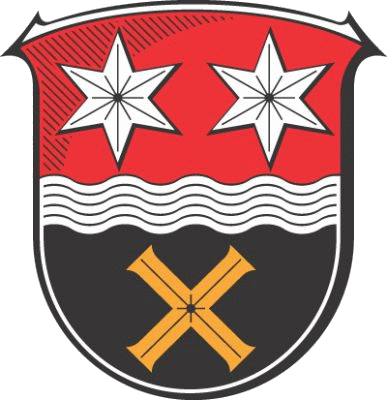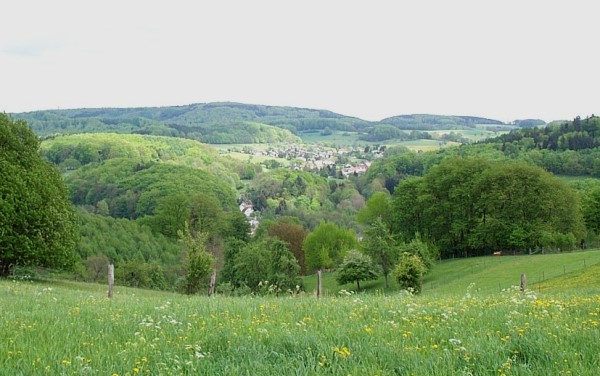|
A typically magnificant view looking from Lautertal into the expanses of
the Odenwald.
|
It is Germany's
second largest area of woodland after the Black
Forest and the most important source of beech wood. The countryside is
very undulating and varies in vegetation and architecture across the
width and length depending, to a greater extent, on the
underlying rock (granite to the west and sandstone to the east). Not a
very wet area with no major waterways crossing it and only one
large dammed lake (Marbach Stausee), it is generally a poor land where
farming and forestry has played a major roll over the centuries. The
climate is very moderate despite the height of the hills and
surrounding countryside being anywhere from 300 to even 600 metres
above sea level (only 2 peaks rise over 600 metres). The western edge
which lines the Rhine rift valley is very mild and enjoys an early
spring and late autumn.
|
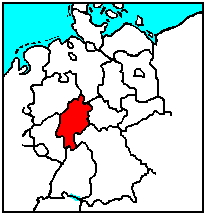 |
Almost
in the geographical centre of Germany is the federal state (German: "Land")
of Hesse
with its capital city of Wiesbaden. Economically well situated, boasting
Europe's second largest airport near Frankfurt, together with the large
banking community in Frankfurt (the European and German central
banks are to be found there), Opel's HQ and largest works are to be
found in Rüsselsheim also near Frankfurt and the German
Telecom with its traditional
HQ in Darmstadt. South Hesse is surrounded by Rhineland-Palatinate to the west (where BASF has its HQ); Baden-Württemberg to the south (hosting SAP) and Bavaria to the east.
|
At
the southern most part
of the state, nestled in the hills of the forest of Oden (Odenwald)
only a few miles east of the Rhine, you will find Lautertal. Politically
it is located within the borough ("Landkreis") of
the Hill Road (Bergstrasse) with
its area capital being Heppenheim (see map below). Heppenheim is now famous as the birth place of Sebastian Vettel, the reigning Formula 1 world champion.
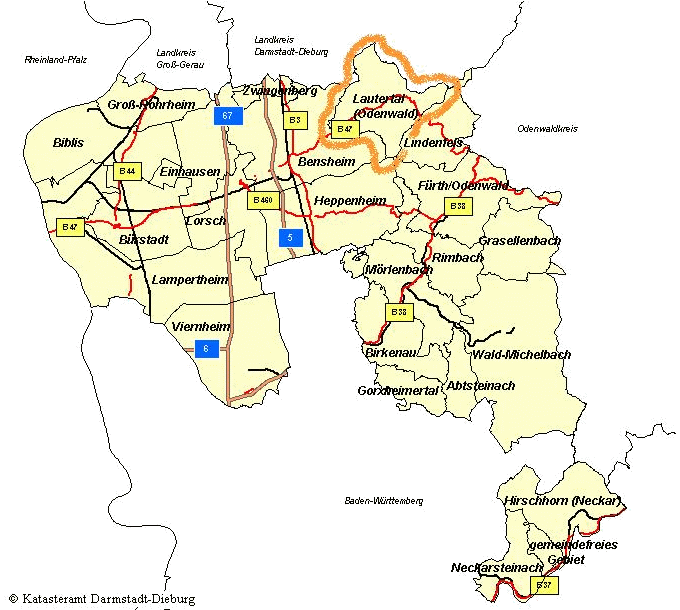
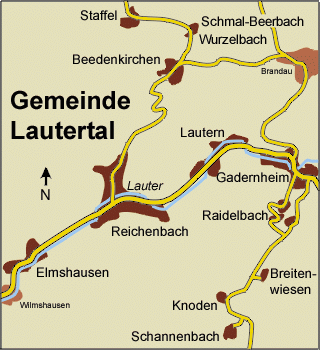 |
Since the
last major political reform of 1972, the Parish of Lautertal
has consisted of a scattering of 12 separate towns and villages
generally following the valley of the small river called Lauter
(see
map left), which flows westwards out of the tree covered
hills of the Odenwald into the Rhine valley at
Bensheim. The largest town of Reichenbach houses
the town hall and council offices and is mentioned in documents as far
back as the 11th century. It has developed
either side of the busy thoroughfare of the B47 meandering its way
through the valley from Worms to Michelstadt via Bensheim. This
route
is called the “Road of the Nibelungs”
(Nibelungenstraße) and
is steeped in the local and national legendary of the Saga
of
the Nibelungs (Nibelungenlied).
|
Lautertal
For the
most part a rural area, modern-day Lautertal attracts many people who
work in the nearby industrial centres of Mannheim, Darmstadt, Mainz,
Wiesbaden and of course Frankfurt to spend their leisure time or even
settle here. Traditionally this area is strongly connected with farming
(cattle, agriculture and apples) and in more recent times stone working
(quarrying, masonry), although there are quite distinct traces of Roman
activity in the area.
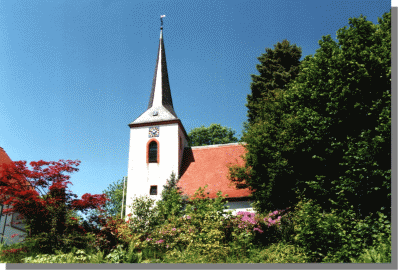 |
Steeped in
tradition, religion has played a very
strong role in the
ancient and more recent history of this area with various dioceses
(predominantly Lorsch), but also dukes and barons owning
various parts of the land in a forever changing political and social
landscape. Predominantly protestant almost every town and village has
at least one major building in the form of a church. The oldest being
in the outlying village of Beedenkirchen (see
photo left) dating from the mid 17th
century.
|
| Away from
the major thoroughfare Lautertal enjoys a quiet and tranquil
existence. Numerous well signposted trails and hiking paths lead you
through the unspoilt countryside commanding spectacular views over the
hills and mixed forests into the depths of the Odenwald
(see photo right) as well as over the vast Rhine
valley. A major national hiking path running
from the north to south Germany cuts through this area. |
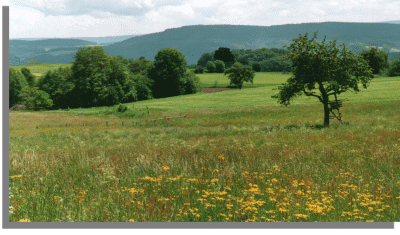
|
Social
life
consists of many activities as a member of any number of sports societies (football, handball, volleyball, tennis etc.) as well as choral and
drama societies, animal/bird breeding clubs, amateur photography and of
course hiking clubs etc. with each town and village having their
“own” voluntary fire brigade. During the course of
a year each club organises its annual event, inviting the general
public to attend concerts, plays or other shows or during the warmer
season barbecues and beer festivals. The most popular common event of
every town and village being the “Kerb” (also known
as “Kirchweih”), a parish festivity celebrating the
inauguration of the church cumulating in a Sunday afternoon procession
through the village where each club has the opportunity of presenting a
well decorated float for this climax of the year.
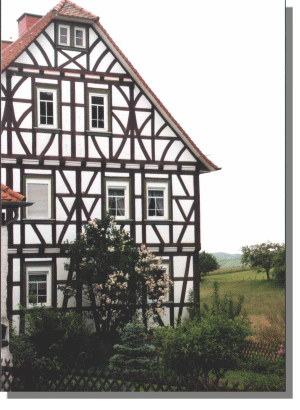 |
Although
Lautertal possesses no historical buildings of any great
importance or fame it is well bestowed with delightful hamlets, country
pubs, old farmhouses and other buildings of timber-frame construction
some of which can be dated back to before the 16th
century. Many lovingly preserved they present the eye with a wonderful
sight (see photo left).
|
| Various
old town and village halls, giving
witness to political times
of days gone-by, have been carefully rennovated and kept in good
condition. The post-modern architectural delight of the Lautertal town
hall in Reichenbach provides a welcome if not undisputed exception (see
photo right). |
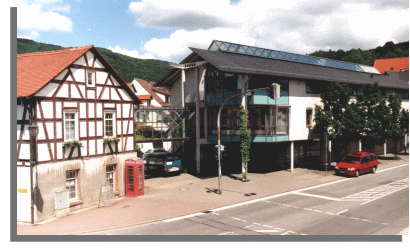
|
The traditional German cuisine has been strongly influenced by Balkan,
Italian and Greek flavours. Nevertheless you can still find any number
of real German “Gaststätten” in and around
the area of Lautertal serving a wide selection of traditional meals and
snacks to suit most palates. Generally still family-run they are very
reasonably priced.
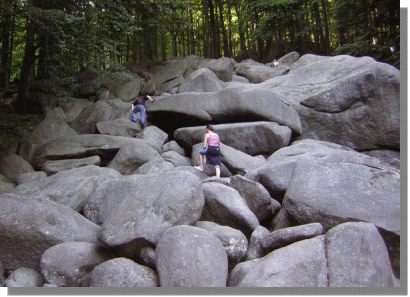 |
The most
important attractions of the area are of unspoilt natural
origin. The most famous and certainly spectacular being the “Sea
of Rocks” (Felsenmeer).
Stretching up the south slope of the Felsberg (514 metres above sea
level) for more than 800 metres, cutting through the majestic woods of
beech trees over a width of up to more than 80 metres is a massive bed
of huge granite boulders beckoning to be climbed and clambered over (see
photo left). |
Since this
can prove to be a very exhaustive
pastime for some, there are many well signposted tracks and paths
skirting and criss-crossing the area and leading to several spectacular
remains of past industrial activities for the others.
|
At the
“Giant
Column” (Riesensäule - see right)
you can take a welcome break at the kiosk and wonder at the skills of
Roman craftsmen who chiselled this rock of 9.39 metres in length and
approx. 1.30 metres in diameter out of one solid piece of granite
(damaged a few years ago by vandals). Fortunately for us they left in a
hurry, fleeing from the advancing Germanic tribes leaving this
magnificent souvenir behind.
|
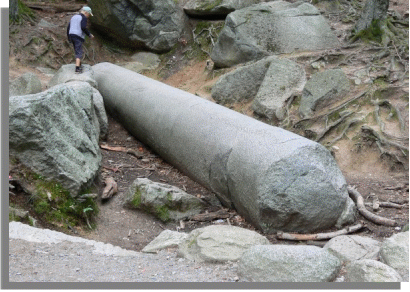
|
Lautertal
has become one of the
gateways into the Geopark
Odenwald, a
UNESCO project. At the lower access
point to the Felsenmeer there is a visitors´
information
centre with guides and rangers providing a whole spectrum of activities
for those who prefer nature trails to adventure theme parks.
|
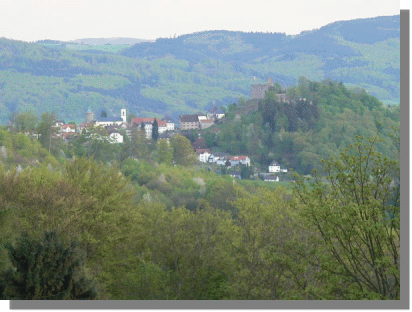
|
To the east of Lautertal extends the full expanse of the Odenwald (left: panorama over Lindenfels and its castle ruins),
being the second largest woodland area in Germany and famous for its
beech trees with forestry being an important economic factor. To the
west are the wide plains of the Rhine rift valley leading to the hills
of the Palatine (Pfalz - has flourishing wine
industry).
|
Bergstrasse
Along the
western foot of the hills of the Odenwald stretches the “Hill
Road” (Bergstraße) is
known for its mild climate.
Spring
arrives here early, presenting the
visitor with a spectacular show of blossoming fruit and other trees and
bushes, long before the rest of the country (see photo right).
|
|
On
the lower peaks along this route you will discover numerous ruins of
castles and fortresses, even an abbey continuing the line of those
found further north on the steep banks of the Rhine. From these vantage
points you can experience wonderful views of the surrounding
countryside. Only a few miles north of the boundaries of Lautertal is a
most famous and well-preserved example called the
“Frankenstein's
Castle”. Perched high up on a hill it is a
place, which
Mary Shelley had apparently visited or passed by providing her
with some inspiration for her famous novel on Frankenstein from 1818
(Tip: Have meal at the restaurant and watch the sunset).
A little
closer to Lautertal you will find the small town of Seeheim
behind which is the worldwide training centre of Lufthansa. Nearby is
the sleepy town of Jugenheim,
which has long ties with the Battenbergs (Mountbatten). There is a
country mansion commanding a wonderful view over the Rhine valley called Heiligenberg Castle.
This was once the family home of Prince Alexander of Hesse and by Rhine
and Princess Julie of Battenberg (the great grandparents of Prince Philip, the duke of Edinburgh - who once visited the place in 2006) who are buried next to the memorial chapel. The estate was sold in 1920 by Louis Mountbatten and, for years after the 2nd WW, was a training establishment for teachers. The place is now a visitors' attraction run by a trust with guided tours around the grounds and a pleasant café/restaurant.
Moving
on south and slightly north of Lautertal on the western slopes of the
Odenwald lies the ancient town of Zwingenberg
being one of the oldest towns in Germany with city rights. The route
continues on through the bustling towns of Bensheim,
Heppenheim and Weinheim leading
finally to Heidelberg all having their wonderfully preserved old town centres that are well worth a visit.
Spread along the southern
banks of the river Neckar Heidelberg has approx. 140,000 inhabitants
and boasts the oldest university in Germany (1386) and the ruins of
an historical fortress residence dating back to before the 13th
century. On the hillside it commands a magnificent view over the river
and beyond - also well worth a visit!
|
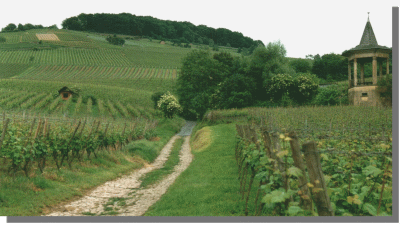
|
Along the eastern perimeter of the Rhine valley on the sun-soaked lower slopes of the
Odenwald, in particular between Bensheim and Weinheim, you will see
many small and relatively unknown vineyards growing some
of Germany’s excellent
wines (see
photo left). These vineyards offer any number of hiking
paths meandering up and down the hillsides presenting the walker with
magnificent views and unforgettable sunsets.
|
Surrounding Areas
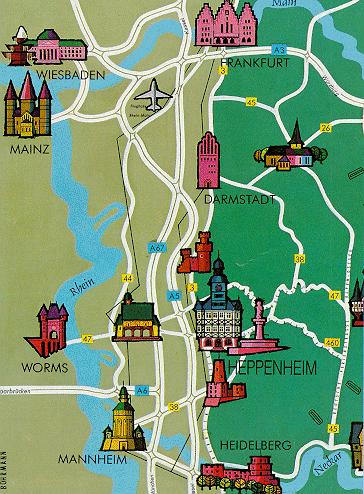 |
Just a
few
miles west of Lautertal in the rift valley of the Rhine you can follow
a trail of ancient history closely associated with the power struggles
of emperors, bishops and monks together with pilgrim routes between
ancient abbeys, monasteries and other religious centres and cultural
shrines crossing throughout the whole of Europe (see map left).
In the vicinity there are the cathedral cities of Speyer,
Worms (see also the Saga of the Nibelungs) and
Mainz.
Nearby and still part of the borough of the Bergstrasse is Lorsch.
This charming town with impressive ruins of a one-time powerful abbey
is UNESCO listed and certainly well worth a visit.
A little further south is the ancient Roman
town of Ladenburg
(Lopodunum).
A town that has often played a strategic role in the numerous struggles
and wars between many tribes and settlers rampaging through this part
of Europe over the past 2000 years. After a multitude of sackings and
plundering over the centuries the town centre is remarkably well
preserved still within the old city walls, full of romantic charm and
very interesting historic buildings. The history of the automobile is
closely connected with this part of Germany. Carl Benz (Mercedes Benz)
ran a business in Ladenburg and spent a great part of his life here
until his death in 1929. He is buried here and in memory of his
life’s work there is an automobile
museum.
|
|
Lautertal
has an active twinning committee
called APEG and has been
twinned with the Parish of Aldenham, near
London/England, since 25th October 1980, with
Jarnac on the river Charente near Cognac/France since 2nd
May 1983 and, as of 5th June 2016, also Dogliani in Piemont, Italy. APEG, chaired by Christiane Stock, would be
only too pleased to accommodate your queries in French, Italian, English or German:
h.c.stock@t-online.de
Should
you
have any further questions on Lautertal please do not hesitate to
contact the local council:
info@lautertal.de
|

|
Note:
:
All links
are correct at the time of compilation. Any changes please email the
local council.
Written, compiled and all photographs: Johnny Glover, Lautertal
© 2002/2008/2011
|
